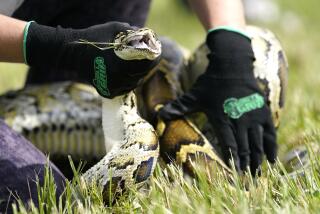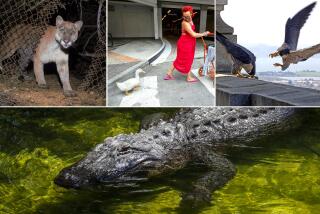Floridians Wrestle With the Blight of the Iguana
KEY BISCAYNE, Fla. â If this were a tabloid newspaper, the headline might scream: Hungry Giant Lizards Invade Florida Towns!
âThey eat the flowers, [go] in the pool and mess it up,â complained Ralph Lindberg, manager of the Commodore Club South, a group of condominiums on this exclusive, palm-fringed island south of Miami. âYou try to chase them, but they live in the tops of palm trees, or in holes in the ground.â
In neighborhoods from Key Biscayne to Boca Raton, it is the night, and day, of the fearsome-looking iguana. Escaped from captivity, or turned loose in the wild by pet owners, the large, usually green-skinned reptiles that can reach 6 feet in length are multiplying rapidly.
Native to Central and South America, the voracious, fleet-footed iguana has no natural enemies in the suburbs of South Florida.
Colonies of the big lizards now inhabit a Fort Lauderdale park, some of the most select communities of Palm Beach County and islets of the Florida Keys. At Fairchild Tropical Gardens, which claims to be the largest botanical garden in the continental United States, the blossom-munching creatures have, like a biblical cloud of locusts, wolfed down rare, exotic plants.
âThey tear apart hibiscus, impatiens,â said Kevin M. Kirwin, manager of Crandon Park, a 975-acre recreational facility on Key Biscayne where more than 1,000 iguanas are believed to live. âThey go chuck, chuck, chuck,â said Kirwin, mimicking their machine-gun-like chomp.
Iguanas, larger than any lizard found naturally in the United States, have the fierce mien of miniature dinosaurs. They are herbivorous, however, and are believed to present no risk to humans beyond the salmonella bacteria they carry and may transmit if handled.
The evident explosion in their numbers is just one more instance of the headaches created in Florida by âexotics,â that is, nonnative species of plants and animals that have gotten loose and found the lush, subtropical setting as much to their liking as humans have.
In recent years, giant pythons have been spotted slithering through the Everglades. A non-American species of fern imported by florists as an ornamental is devastating tree islands in a wildlife preserve west of Boca Raton. In Cape Coral on Floridaâs Gulf Coast, carnivorous Nile monitor lizards, an African species that can grow almost as big as iguanas, may already number in the thousands, and could endanger the local population of burrowing owls.
In the Miami area, at least 40 nonnative species of reptiles and amphibians can be found, often feasting on native species and reducing their numbers, said Josiah Townsend, a herpetologist from the Florida Museum of Natural History in Gainesville. Among the intruders, iguanas are some of the most successful. A female, on average, lays 50 papery-skinned eggs at a time, and may breed twice a year. With no natural predators to keep their numbers in check, the reptiles appear to be thriving.
âOnce theyâre in, there is no way to get them out, except doing things we cannot do, like chemical warfare,â Kirwin said. In theory, a good, long cold snap should kill the iguanas, and a drop in temperatures last winter did thin their numbers, Crandon Parkâs director said. But the lizards learned that if they stayed in water, they had a better chance of keeping warm, he said.
At Ocean Village Condominiums near the park, hordes of iguanas coming over the fence have devoured the hibiscus bushes and fouled the grounds with excrement. Employees put out cages to trap them, but the reptiles quickly became wise to the danger and avoided them.
âWe try to capture them. The biggest one weâve caught was 5 feet, 4 inches,â said Jim Dowd, manager of the four-story, 140-unit complex. âIf you met that guy in an alley, you would be pretty scared. They might whip you with their tails.â
At one point, Dowd hired a trapper but said the fast-running lizards managed to elude him. On occasion, he says, his groundskeepers use a pole to knock a roosting iguana off of its perch in a tree, then kill it with poles on the ground.
âThey defecate, and it smells bad and is unhealthy,â the condo manager said. âI have lost a lot of foliage to them.â But despite having to cope with what he calls a âbig, bad nuisance,â Dowd speaks of the animals with something akin to awe.
âThe iguanas have the knowledge of millions of years stored in their computers. Itâs in their brains. Iâm always amazed by them,â he said.
Townsend, a 25-year-old herpetologist from Miami, has also grown to respect the lizardsâ keen intelligence. This summer, he has gone specimen-trapping in South Florida, and found the iguanas living at Bill Baggs Cape Florida State Park, at the southern tip of Key Biscayne, have learned not only to recognize a fellow trapperâs voice, but the truck she drives and the uniform she wears as well.
âThey flee once theyâve figured out what youâre doing,â Townsend said.
At the Commodore Club South, âthe owners are always complaining at the office about them,â said Lindberg, the manager. On occasion, he said, iguanas join residents in the pool.
Iguanas are excellent swimmers and can stay underwater for 15 minutes. They perch in trees near lakes, ponds and canals, and drop into the water if they hear a menacing sound. Coldblooded, they are quick to react when temperatures are hot but become sluggish, almost dormant, when it turns cold.
In parts of Latin America, their roasted flesh is a delicacy. But Kirwin, a former Marine, said he doubted the custom would catch on in South Florida.
Iguanas may have established a toehold in the Sunshine State a half-century ago. Some may have been stowaways on freighters plying routes between their homelands and Miami, but most were probably released by pet owners and dealers aghast at how huge the beasts had grown.
Florida law allows keeping the animals as pets but outlaws the introduction of iguanas or any other nonnative species into the wild. âNow youâve got more people in more places, and they dump more of their pets, and populations spring up all over the place,â Kirwin said.
Valerie Cassidy, president of the Gardens of Crandon Park Foundation, has become resigned to coexisting with the intruders, which she calls both an attraction for visitors and a nuisance. Her organization pays for the plants that go into the 43-acre gardens and raises funds for their upkeep.
âYou have to plant, and hope for the best,â she said. âYou end up planting three times. The penta flower, which originated in Egypt, is one of their favorites. Itâs about 1 to 2 feet tall, with clusters of tiny little flowers. [The iguanas] are finicky; they might eat the plants on the west side of an area, and not on the east side.â
On islands in the parkâs lakes and ponds where weddings are held, members of the foundation have elected to plant bromeliads, because they have found iguanas wonât eat them.
Cassidy, who has been involved with the gardens for more than 15 years, finds the iguanas ânot really pretty.â
âThey run through my legs, bang into my legs. They donât look ahead; they see sideways,â she said. âOnce, an iguana licked my shoes, licked my legs, and gave me a friendly bite.â
*
Times researcher Anna M. Virtue in Miami contributed to this report.
More to Read
Sign up for Essential California
The most important California stories and recommendations in your inbox every morning.
You may occasionally receive promotional content from the Los Angeles Times.










